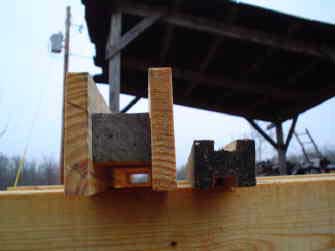Should I Season Timbers Before Framing a Barn?
Timber-framing works well with green or partially dried timbers, but you should allow for some drying-related movement after construction. May 9, 2007
Question
I've been cutting timbers for a post and beam barn I am planning to build. My question deals with how long to wait before starting to make my joints and otherwise assembling the barn. Ive heard rules like a year per inch of thickness, but it seems a bit impractical to cut 6x6's or 5x8's and wait 6 years to build. I assume there are some construction techniques to allow to some extent for future shrinkage. Any advice will be most appreciated.
Forum Responses
(Sawing and Drying Forum)
From contributor P:
For this type of construction about 6 to 9 months if they are racked (stickered) and covered they should be pretty close to 20 to 25 MC. Good enough for a barn. If you side it with air dried rough, butt them tight, the shrinkage will still give you a little gap. They also sell moisture meters that will let you know when the moisture content stabilizes.
From contributor T:
I'm not an expert, but I took a one-week workshop recently and the guy doing it said to build as soon as possible. You certainly do not want to try to cut mortises and tenons in dry oak, or dry anything except pine. Most timber frames are built with green timbers. I will be building soon, and I am waiting to saw until just before building.
From contributor M:
Build green. Your joints will tighten as they shrink. Also, some of the beams will twist and warp and while you can take some irregularities out of a 1X8 0r a 2X10 while building, you will not mover a 6X6. I have tried both ways with pine and douglas fir.
From contributor A:
Saw and sticker as you go leaving lots of air space between the rows and between the timbers. I use "H" stickers that are 2x2 or 4x4 depending on the size of the timbers and weight of rows. Sawing all the timbers for a bent in the same day is a good deal and keeping them together will help. I wait a month or three if possible to see if one is going to start twisting. When all timbers are sawed and settled I start cutting the joints then stacking back together. Then we fit and raise the frame.
So for the most part you work with a green timber. Your pegs should be dry. You should not close the frame in for some time to allow it to dry after the roof and side walls are on but, with a barn that should not be an issue. Here is a picture below.

From contributor D:
I built my timberframe home using red oak that I cut on my
Woodmizer. I cut all the timbers one inch oversize and stacked them for up to a year. Before cutting the joints, I resized them to 1/8" oversize to allow for planning. I had no problem with warping or twisting. You will have some gaps but for a barn you shouldn't care. Use good dry oak pins for all of the mortise and tenon joints. Your shrinkage will only be between the pins holding your tenons. I just cut a mortise in a dry white oak timber recently and it was tough. Go with the green or partially dry.
From contributor P:
That is sound advice Contributor D. Cutting a mortise in dry anything can be a little easier if you use a drill motor with a sharp bit to remove as much as possible. Larger timbers/mortise can be edged with a Sawzall or appropriate handsaw - then adjust the final fit only with the chisel. If the timbers are green you want the mortise and tenon to be a little loose.
